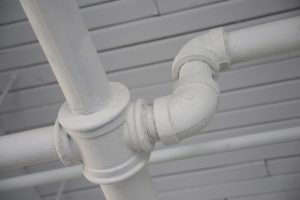
Knowledge Base / News
Every business takes steps to protect themselves against damage. For instance, every building is equipped with smoke detectors and fire suppression systems and extinguishers. Purchasing business insurance to help recover from damages is a must as well.
Damage to your building can come from a lot more than fire and smoke, however. Yes, insurance will help pay for repairs and recovery, but wouldn’t it be better to avoid damages in the first place?
One of the most common causes of damage during cold weather is frozen pipes, and the flooding that comes as a side effect. Just a few days ago a high school needed to cancel classes for an entire day after suffering from frozen pipes over the weekend. Thankfully not much tech equipment was lost, but hundreds of brand new textbooks were.
 The frozen pipes were caused by a heater that stopped working over the weekend, causing temperatures within the school to plunge thanks to a recent cold snap. If the school received notification over the weekend that temperatures were dropping rapidly, they could have repaired the heater and avoided the burst pipes and flood damage. Unfortunately, they weren’t aware of the heating problem, and as a result the frozen pipes caused thousands of dollars in damages.
The frozen pipes were caused by a heater that stopped working over the weekend, causing temperatures within the school to plunge thanks to a recent cold snap. If the school received notification over the weekend that temperatures were dropping rapidly, they could have repaired the heater and avoided the burst pipes and flood damage. Unfortunately, they weren’t aware of the heating problem, and as a result the frozen pipes caused thousands of dollars in damages.
Imagine this scenario happening in a multi-story, multi-tenant business. A heating system fails over a long, cold weekend, resulting in frozen pipes on the top floor. The pipes then burst from the pressure, leading to water cascading down the walls all the way to the basement level, damaging critical paperwork, equipment, furniture, and likely the building itself.
How much revenue is lost in this case? How much down time will this lead to for each business in that building? How much will it cost to repair the building? Losses could be in the hundreds of thousands of dollars, if not millions based on the damage.
Insurance will help pay for those damages, but when this happens, the revenue and productivity lost simply can’t be recovered.
Installing proactive temperature and flood monitoring will help prevent unexpected damages from occurring. You’ll be notified when environment conditions reach levels either above or below ranges that may indicate equipment failure or the need for intervention. Proactive maintenance is far more preferable than spending weeks recovering from damages.
In the examples we noted above, a simple temperature alert to a building facilities manager would have indicated a heating or boiler failure, and led to immediate repairs. The temperatures would not have dropped to the freezing range (or if they had, it would have been for only a short period) and the pipes would not have frozen.
In addition, flood sensors would have provided immediate notification if there was water detected anywhere around one of the sensors. Even in the event of a water leak or damaged pipes, the earlier you receive notification of water being detected, the faster you’ll be able to act and prevent more costly damage from occurring.
Far too many people hear “flood damage” and think that they aren’t at risk because their building isn’t located near large bodies of water, not even considering all the other sources flood damage can come from. It is far better to put flood monitoring into place than to come into work on Monday morning and discover a pond on your building’s first floor.
Flood damage can come from many other places than just frozen or damaged pipes… and your business is likely at risk for many of them. Implement environment monitoring as part of your business continuity plan and include flood monitoring to help keep your building, assets, data, and tenants protected today.
If you have questions about the different types of temperature monitoring and flood sensors available that can help protect your business, please let us know! Our Product Specialists are experienced in helping put together customized monitoring plans and packages to help businesses of all types and sizes. Contact us today at 401.628.1600, toll free 888.220.6700, or via email Sales@AVTECH.com. Don’t delay! Always remember, ‘Proactive Monitoring’ is better than ‘Disaster Recovery’.

You may find Windows Command Prompt at the following path:
To run Windows Command Prompt as an administrator:
| Current S models | Current E models |
|---|---|
| Room Alert 32S | Room Alert 32E |
| Room Alert 12S | Room Alert 12E |
| Room Alert 3S | Room Alert 4E |
| Room Alert 3E | |
| S models | E & W models |
|---|---|
| Room Alert 32S | Room Alert 32E |
| Room Alert 12S | Room Alert 12E |
| Room Alert 3S | Room Alert 4E |
| Room Alert 3E | |
| Room Alert 3W |
| Model |
|---|
| Room Alert MAX |
| Room Alert 32S |
| Room Alert 12S |
| Room Alert 3S |
| Room Alert 32E/W |
| Room Alert 12E |
| Room Alert 4E |
| Room Alert 3E |
| Room Alert 3 Wi-Fi |